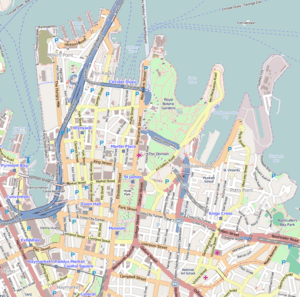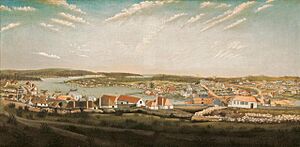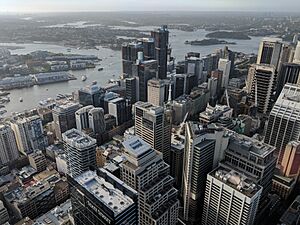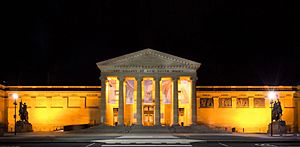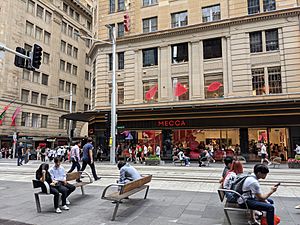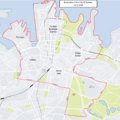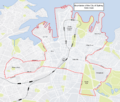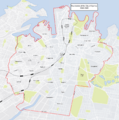Sydney central business district facts for kids
The Sydney central business district (CBD) is the main city area of Sydney, Australia. It's often called "Sydney City" or just "the City." This important area stretches about 3 kilometers (1.9 miles) south from Sydney Cove, which is where the first European settlers arrived.
The CBD is a busy place, running from Circular Quay in the north to Central Station in the south. On the east side, you'll find beautiful parks like Hyde Park, The Domain, and the Royal Botanic Garden, all near Sydney Harbour. To the west, there's Darling Harbour.
Sydney's CBD is a major center for money and business in Australia. It's also a key spot for fun and entertainment, especially at night. Many of Sydney's most famous buildings are located here.
Quick facts for kids Sydney CBDSydney, New South Wales |
|||||||||||||||
|---|---|---|---|---|---|---|---|---|---|---|---|---|---|---|---|
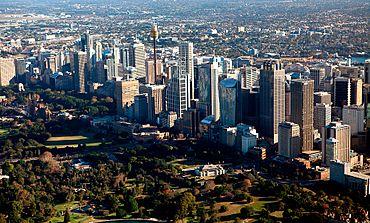
Sydney city centre
|
|||||||||||||||
| Postcode(s) | 2000 | ||||||||||||||
| Elevation | 58 m (190 ft) | ||||||||||||||
| Area | 2.8 km2 (1.1 sq mi) | ||||||||||||||
| LGA(s) | City of Sydney | ||||||||||||||
| State electorate(s) | Sydney | ||||||||||||||
| Federal Division(s) | Sydney | ||||||||||||||
|
|||||||||||||||
Contents
City Layout and Landmarks

The Sydney CBD is packed with tall skyscrapers and buildings. But it also has many green spaces like Hyde Park, The Domain, Royal Botanic Garden, and Wynyard Park.
George Street is the main road that runs through the CBD from north to south. It's a very busy street!
The city center sits on two main ridges. Between them is Pitt Street, which is the main shopping area. Here you'll find the Pitt Street Mall and the famous Sydney Tower. Macquarie Street is a historic area with important buildings like the State Parliament House and the Supreme Court of New South Wales.
City Boundaries
The official name for the central business district is "Sydney." This area covers most of the land between Cockle Bay in the west and Woolloomooloo Bay in the east. It goes north to Circular Quay and east to the edge of Hyde Park. To the south, it reaches Goulburn Street, just north of Sydney's Chinatown. To the west, it includes the Darling Harbour area.
However, some nearby areas like Barangaroo, The Rocks, and Millers Point are separate suburbs. The postcode for the city center is 2000.
Sydney's Rich History
Sydney's story began long ago with the Australian Aboriginals. Their ancestors lived here for at least 30,000 years. The Cadigal clan lived around Sydney Cove. The main language groups were Darug, Guringai, and Dharawal.
Modern Sydney started in 1788 when the First Fleet of British ships arrived. They came to set up a new colony. The "Eora people" were the Aboriginal people living along the coast of Sydney. The name Eora simply means "here" or "from this place."
After checking out Botany Bay, Captain Arthur Phillip decided it wasn't a good spot. It had poor soil and no safe harbor. So, the fleet moved to Port Jackson. They set up a settlement at Sydney Cove on January 26, 1788. This date is now Australia Day, a national holiday. Captain Phillip called Port Jackson "the finest Harbour in the World."
As more Europeans settled, they cleared land for farms. This destroyed the Aboriginal people's food sources. New diseases like smallpox also arrived. These things made the Aboriginal clans upset, leading to fights with the British.
Australia's oldest law-making group, the New South Wales Legislative Council, was formed in Sydney in 1825. It advised the Governor of New South Wales. The first Parliament House was set up in a part of the Rum Hospital in 1829. In 1840, the Sydney City Council was created.
Governor Macquarie set aside land for churches. The foundation stone for the first St Mary's Catholic Cathedral was laid in 1821. The current St Mary's Catholic Cathedral, a towering gothic-style building, began construction in 1868.
In 1898, the beautiful Romanesque Queen Victoria Building (QVB) was finished. It was built where the old Sydney markets used to be.
During World War I, in 1916, there were riots in the CBD near Central Station. About five thousand military recruits caused damage to buildings. People with "foreign" names were especially targeted. These riots led to a law that pubs had to close by 6 pm. This law stayed until 1955.
From the early 1960s, many new, modern skyscrapers made of concrete and glass were built in the Sydney CBD.
How the City is Governed
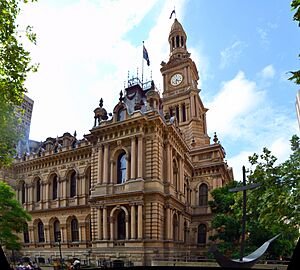
The City of Sydney council is in charge of the Sydney CBD. The New South Wales state government also helps manage parts of the CBD.
In the state parliament, the area of "Sydney" covers the city center and some nearby suburbs. Independent Alex Greenwich has represented this area since 2012.
In the federal parliament, the area of "Sydney" also covers the city center and a larger group of suburbs. Australian Labor Party member Tanya Plibersek has represented this area since 1998.
Business and Economy
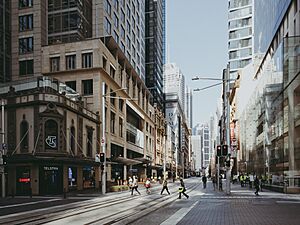
The Sydney CBD is home to many of Australia's biggest companies. It also serves as a main office for many large international companies in the Asia-Pacific region. The financial industry, like banks and insurance companies, uses a lot of the office space. Companies such as Westpac, Commonwealth Bank, Citibank, and Macquarie Group all have offices here.
Getting Around Sydney CBD
Sydney's CBD has great public transport. You can get around by train, light rail, bus, and ferry.
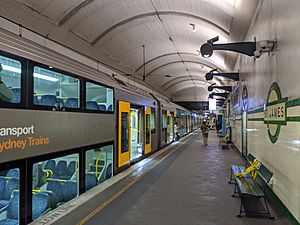
The main train station is Central Station, located just south of the CBD. From Central, there's an underground train loop called the City Circle. It stops at five CBD stations: Town Hall, Wynyard, Circular Quay, St James, and Museum.
The CBD and South East Light Rail runs through the CBD, connecting Circular Quay with Central Station and the Eastern Suburbs.
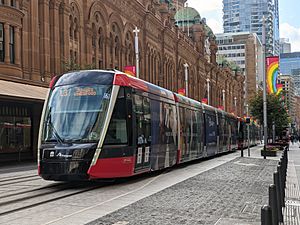
Buses serve the CBD on many routes to both nearby and farther suburbs. The NightRide bus service runs after midnight, mostly from George Street.
Sydney Ferries operate from Circular Quay, on the northern edge of the CBD. You can catch ferries to many places, including Manly.
A new underground train line, the Sydney Metro City & Southwest, is being built. It will connect the northwest suburbs to the CBD and then to Bankstown. Another new line, the Sydney Metro West, will connect the CBD to Parramatta.
Culture and Fun
Sydney's cultural heart is in its CBD and inner city. It's full of nightlife, people, and famous attractions. Many cultural places are in the CBD, including the Museum of Sydney, the State Library of New South Wales, the Theatre Royal, and the City Recital Hall. There are also 19 churches in the city center.
Other cultural spots are just outside the CBD. These include the Sydney Opera House and the Museum of Contemporary Art to the north. To the east, you'll find the Australian Museum and the Art Gallery of New South Wales.
Every January, the city celebrates with the Sydney Festival. It features Australian and international theater, including Aboriginal performances.
The Sydney Film Festival is an international event held every June. It started in 1954 and shows films at different places across the CBD.
Sydney has a lively café culture and many clubs and bars. These are found throughout the CBD, especially around Darling Harbour. Oxford Street is known for Sydney's gay scene.
City Architecture
The Sydney CBD has many of Australia’s tallest skyscrapers. These include Governor Phillip Tower, MLC Centre, and World Tower. The tallest building is Sydney Tower at 309 meters (1,014 feet) tall. Recently, the height limit for buildings was raised to 310 meters (1,017 feet).
Sydney's CBD shows a mix of old and new buildings. Some old buildings date back to when Sydney was first settled. Others are grand Victorian-style buildings from the Gold Rush era. Modern buildings are mostly tall skyscrapers. The first skyscraper in Sydney was Culwulla Chambers, built in 1912. It was 50 meters (164 feet) tall and had 14 floors.
People of the CBD
In 2021, the population of the Sydney CBD was 16,667 people.
About 22.3% of the people were born in Australia. Many others came from Indonesia (12.9%), Thailand (12.4%), China (9.7%), India (3.5%), and South Korea (3.1%). Aboriginal and/or Torres Strait Islander people made up 0.3% of the population.
People in the CBD come from many different backgrounds. The most common ancestries are Chinese, Thai, English, Indonesian, and Korean. People also have diverse religious beliefs. The largest group (36.1%) reported having 'No Religion.' Other common religions include Buddhism (21.4%) and Catholicism (13.7%). Most homes (99.2%) were flats or apartments. In 2021, 72.0% were rented, and 24.2% were owned.
Images for kids
-
Market Street in January 1986, showing Sydney Tower and the now defunct Sydney Monorail
See also
 In Spanish: Centro de Sídney para niños
In Spanish: Centro de Sídney para niños




